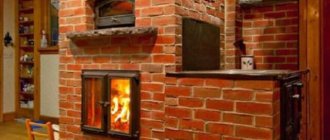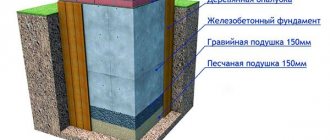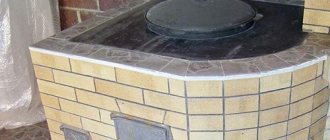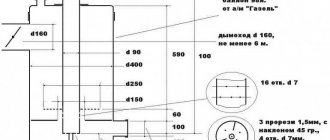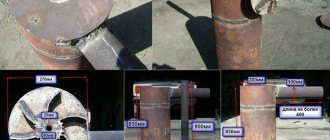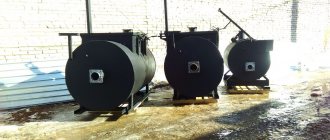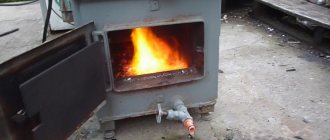Among brick structures, it is the two-bell heating and cooking stove with an oven that remains relevant. The design combines 2 important functions - heating the room and the ability to prepare food due to the presence of an oven and hob. An interesting fact is that a similar two-bell Kuznetsov stove with an oven can be installed with your own hands without excessive effort, but using a simple ordering scheme and taking into account general recommendations.
Do-it-yourself Kuznetsov stove: arrangement drawings and description of the stove laying
Since 1962, I.V. Kuznetsov has been designing, manufacturing and improving furnaces.
During this time, more than 150 different designs were invented, each of which strived for an absolute efficiency indicator - 95% efficiency. In this article we will tell you how to make a Kuznetsov stove with your own hands. Photo 1 Kuznetsov stove
The fundamental feature of the development is the system for separating gases into cold and hot flows. Due to the unique bell-shaped structure of the stove, hot air is retained inside, and cold air is discharged through a separate channel into the chimney pipe. Considering that a higher combustion temperature is maintained in the bell, and the heat is distributed evenly throughout the body, the efficiency reaches its peak. For comparison, the efficiency of conventional stoves is 30-35%, solid fuel boilers - 80%, pyrolysis boilers - 85%.
The low performance of most solid fuel units is explained by the fact that warm air exits along with combustion products into the chimney. In addition to the fact that the remaining volume is not always enough for full heating, quickly escaping flue gases further reduce the thermal threshold. In some designs, they try to solve this problem by increasing (lengthening) the chimney pipe, but then there is a risk of reducing draft and, as a consequence, reducing efficiency. The creation of such a unit that would provide full traction and increase heat transfer became the main goal of designer Kuznetsov.
Video 1 Construction of a heating furnace using the Kuznetsov system
Construction of a Kuznetsov furnace with your own hands
The sequence of actions is as follows:
First, they study the floor plan of the room where the heating device is planned to be installed. In the case when the house is not built, it is necessary to ensure uniform heating of all rooms. It is not advisable to install a heating unit into a finished building, but if necessary, you can
But at the same time, you should take into account the location of the supporting structures and beams when arranging the chimney. Then the foundation for the heating device is prepared. It is made of concrete, and the width should be 10 centimeters greater than the size of the device
It is advisable to design the foundation for the stove at the house planning stage.
What materials and tools are used?
Construction work will be impossible without the use of appropriate equipment and necessary materials. Before starting construction, you need to make sure that ready-made components are available. For a bell furnace you will need the following material:
- red and fireclay brick;
- waterproofing sheet for the foundation;
- metal corner;
- mortar kit (sand, clay, cement);
- combustion door, cleanout door, ash door;
- grates;
- cooking surface (presumably cast iron);
- oven;
- chimney valves of different sizes;
- reinforcing mesh.
In addition, the work will not be ensured if the following tools are not available:
Kinds
According to their purpose and design features, blacksmiths can be divided into several types:
- Heating. The devices are designed for efficient and safe heating of premises.
- Cooking. Used for cooking. This includes ovens for baking bread and bakery products.
- Bathhouses. The Kuznetsov bathhouse stove is designed for simultaneous heating of the main bathhouse premises. Such devices have high heat transfer with minimal fuel consumption.
- Street. A stove complex consisting of a grill or barbecue for outdoor cooking.
- Fireplace. The equipment is used as a decorative element of the interior or as an additional heating option. Some fireplace stoves are equipped with special loungers for a pleasant leisure time.
The most popular are complex devices that are distinguished by their multitasking. A striking example is the Kuznetsov heating and cooking stove, which is intended both for heating residential premises and for preparing food.
Despite their functional features, all stoves operate on the same principle - effective distribution of heated gases in the bell into separate streams.
It is noteworthy that stove hoods can be equipped with additional equipment - electric heaters, hot water tanks, steam generators, oven and stove.
A competently designed and constructed Kuznetsov sauna stove will provide reliable heating in all functional rooms: steam room, washing room, dressing room, rest room. In addition, it will allow you to quickly heat water, accumulate hot steam and purify the air.
Operating principle of Kuznetsov bell furnaces: ordering
The operating principle of Kuznetsov furnaces is not complicated. When building a furnace, it is necessary to carry out all work according to drawings, diagrams and, of course, use procedures.
All Kuznetsov bell furnaces operate on the principle of separating combustion products. This principle lies in the fact that the gas generated as a result of fuel combustion is divided into two streams: cold and hot. The movement of gases inside the furnace design is very well thought out. Hot air is retained in the oven and retains heat for a long time. Cold air quickly flies into the chimney through a specially made recess. A furnace operating on this principle is called a bell-type (dome) furnace. Inside such a furnace, the hearth is combined with its lower part and forms something like a hood. It then acts as a gas separator into two streams. The flow of hot air rises and is retained in the hood, thus concentrating heat.
Advantages of Kuznetsov stoves:
- Cost-effective;
- Long-term heat retention;
- Slight soot formation;
- No need for frequent cleaning;
- A choice of different shapes and designs is possible.
The high efficiency rate (95%) of Kuznetsov furnaces is the result of a fundamentally new development and design features. For comparison, a traditional Russian stove has an efficiency of 25-40%. If Kuznetsov stoves have disadvantages, then they are few, and they are lost against the background of their advantages.
Operating principle of the furnace
Most furnace designs operate by directly heating the walls from the combustion of fuel in the combustion chamber or by heating the brickwork from furnace gases passing through a complex system of air ducts in which hot furnace gases transfer heat to the brickwork.
In the first case, the heat capacity of the furnace is determined by the thickness of the walls. The thicker they are, the more heat-intensive the oven will be. Their disadvantage is the high fuel consumption for warming up. As soon as the combustion stops, the stove begins to cool down.
Furnaces with a complex air duct system allow the “body” of the heating structure to be heated more evenly, but the long passage of furnace gases through strongly curved air ducts places increased demands on the draft and height of the chimney.
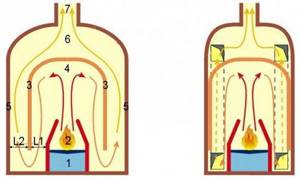
Bell-type furnaces are free of these disadvantages due to their design, in which two independent heat-accumulating circuits are formed. The inner, highly heated contour of the cap is located inside the outer, less heated contour. Therefore, cooling in the absence of direct contact with outside air occurs much more slowly. The oven stays warm much longer. All heated furnace gases remain inside and are not released outside.
Recommendations for self-construction
If you decide to build a stove according to one of Kuznetsov’s plans with your own hands, get ready for careful and scrupulous work. On the diagrams you will find a graphic representation of each row, but before starting laying you need to become familiar with the features of the technique, in particular:
- selection and pre-processing of bricks;
- purchase of metal parts (plates, dampers, doors, valves);
- determining the most suitable location;
- preparation of the base and foundation;
- possibility of installing a chimney, etc.
Fireclay refractory brick (Sh-5, ShB-8) is recognized as the best material for the internal masonry of “smiths”, and ceramics (M-150) for external decoration. To strengthen brick walls, metal elements (rebar, wire) are used. In order for the stove to function with maximum heat output, experienced craftsmen hone not only their skills, but also every brick - literally. They polish every detail, which is why projects completed by professionals look flawless.
Fireclay brick masonry
Having the author's order in hand, we recommend not to experiment, but to follow the designated order. Deviations from the diagram do not guarantee complete heat transfer.
Materials for masonry Two-bell Swedish
The amount of brick depends on the height of the second furnace hood and the amount of scrap in the pallets; on average, 2 pallets of bricks are needed to lay a furnace. - combustion door DT-3, landing size 250x210mm - 1 piece; -cleaning doors, landing size 130x130 mm - 4 pieces; - blower door with landing size 130x250 mm - 1 piece; - cast iron plate P2-1 with mounting size 585x340 mm - 1 piece; - cast iron grate RD-3 for a small oven or RD-6 for a large room - 1 piece; - fireclay brick ShB-5 approximately 70 pieces; - scaffold ShB-6 approximately 70 pieces; - ceramic brick GOST 503-2007 - about 700 pieces; - cast iron valve ZV-3 size 290x190 mm - 2 pieces; -metal corner 50 mm - approximately 700 mm; - clay-sand mortar - approximately 300 kg. - fireproof solution (Mertel-28) - 50 kg.
What is the difference
The main feature of the group of stoves invented by Kuznetsov is the absence of extended smoke channels with many turns and bends. To make the most of the heat from burning fuel, duct stoves have a system of passages through which hot smoke heats the bricks. In this case, the oven heats up unevenly at different levels, which can lead to cracking of the masonry. In addition, there is a need for regular cleaning of narrow places and corners.
Kuznetsov's stoves for home and bathhouses do not have this drawback. In them, hot gases from the firebox enter the so-called hood - an internal space limited at the top by the ceiling and having an outlet at the bottom. The heated smoke rises to the very top of the hood, where it lingers until it begins to cool. As they cool, they gradually fall down along the walls of the bell, and a new portion of smoke takes their place.
The cooled smoke exits through the channel into the chimney or into another hood, depending on the design and purpose of the stove. Gradually, as it passes through cascades of hoods, the flue gases cool to a temperature of 120-150 degrees. The temperature of the gases at one level of each cap is the same, which avoids uneven expansion of the brick.
Features of bell furnaces
- A distinctive feature of Kuznetsov stoves is the firebox (combustion chamber) isolated from the main masonry, which is made of fireclay bricks. This is due to the high temperature inside the chamber, which can reach 1200 °C. Uneven expansion of fireclay bricks and ordinary ceramic bricks without a gap between the combustion chamber and the wall would inevitably lead to cracking of the stove. The space between the firebox and the wall is usually 5 mm. In order to increase heat transfer, it is filled with a mineral sealant: asbestos or mineral cardboard.
- The second feature of the Coppak stove is the presence of a “dry seam” - a narrow (20 - 30 mm) gap in the wall of the combustion chamber, which is filled with breathable mineral material (mineral or asbestos wool). The dry seam is designed for additional air flow into the combustion chamber from the internal volume of the furnace. The influx of heated air increases the combustion temperature of the fuel and contributes to more economical consumption of firewood.
- Another feature of a bell-type furnace is the location of heaters, water-heating tanks and ovens in the volume of the second bell. This arrangement prevents direct contact of pipes or the metal casing of additional equipment directly with an open flame or hot gases. The temperature in the second cap usually does not exceed 400 ° C, which is quite safe for metal.
- A bell-type stove has a relatively short chimney. Its task is to remove combustion products, and only secondarily to create draft in the furnace.
- The efficiency of bell-type furnaces of some models reaches 80% compared to max. 60% for stoves of other designs. Thanks to the small size of the combustion chamber, fuel consumption is very economical. It is 20 - 50% lower than in furnaces with direct-flow exhaust of furnace gases.
Design and operating principle
Bell furnace design
The stove with a hood was developed by engineer Igor Kuznetsov in the early 60s of the last century. Subsequently, Russian metallurgist Leonid Kotlyar improved the design so that it retains heat for up to 19 hours. The peculiarity of the “blacksmith” is that the heated air does not leave the pipe, but is collected under a hood. Slowly it cools down and is forced out by rising hot streams. Saving heat is the advantageous difference between a bell-type stove used for heating a house and a channel stove, where hot air, under the influence of draft, freely escapes to the street.
A two-meter-high structure with a base of 1m*1m can reach a thermal power of 3.5–4.5 kW. Such a bell-type stove is enough to heat a house of 50 square meters in a temperate climate zone, if you heat it twice a day.
The inventor improved the design by adding another cap. In Kuznetsov’s two-bell heating stove, the first covering element is connected to the combustion compartment and separates the cold and heated flows. The second cap is located in the upper part of the stove, trapping hot air, which, before entering the chimney, gives off heat to the bricks for a long time.
A two-bell stove uses fuel more economically and is usually equipped with a hob. This allows you to cook delicious meals without consuming electricity or gas. The design of the stove already includes an exhaust hood - there is no need to install an additional ventilation system.
The history of the creation of a bell furnace
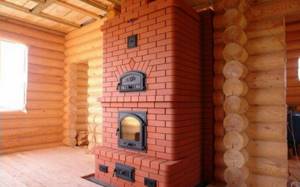
A talented craftsman in the early 60s began searching for a solution on how to obtain greater heat output with a small volume of fuel. After more than half a century, Kuznetsov’s furnaces have become the most efficient. The first structure was built immediately after the start of research. Since then, the unique development has been modernized many times as a heating device and a device for preparing hot food.
A team of like-minded designers conducted more than one and a half hundred studies. Engineer I. S. Podgorodnikov and Russian professor V. E. Groom-Grzhimailo took part in them. The developments covered the entire range of models of household stove devices. As a result, the efficiency of modern Kuznetsov furnaces reaches 80 - 94%. The design becomes famous due to its positive characteristics and good user reviews.
Double bell oven
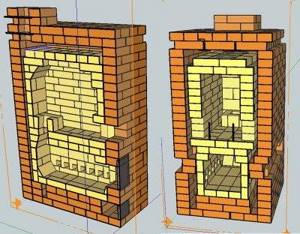
The most common option for high-quality heating of a private home is the Kuznetsov device with two hoods.
Its efficiency is significantly higher due to longer retention of hot air.
The heat-resistant brick hoods are located one above the other with a slight offset - the air displaced from the first hood immediately enters the second, from which it goes into the exhaust pipe.
The size of such a stove is directly dependent on the area of the house; it is even possible to build with an internal volume of up to 5 cubic meters. m. The firebox usually occupies the entire base area, this helps to increase the heating power of the air in the furnace.
d79996939d6d9526a6f20a7cb2b08264.jpe
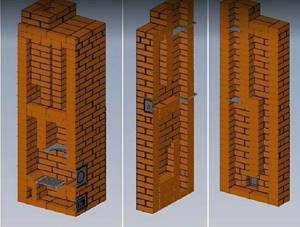
18ae580d3f50fc0040ae71d956f18099.jpe
Reference. In the design of a two-bell furnace, special valves are often installed to insulate the second bell and reduce the heat transfer of the device. This is necessary in warmer times of the year, when high heating power is no longer required.
When using dampers, hot air from the first hood is directed directly into the chimney.
Operating principle of double-bell equipment
The heating and cooking stove with oven is designed in such a way that maximum accumulation and conservation of thermal energy occurs for a long time. This ensures its effectiveness. To understand such a model, its internal structure, and operating principle, you should consider the presented diagram.
So how does a two-bell oven work? It is worth immediately noting that this type of equipment has two autonomous operating modes:
- Summer mode involves using the oven during the warm season for cooking. In this case, the valve blocks other parts of the structure, and hot air does not flow there. This allows the device elements to remain cool.
- During the winter period , it is necessary to open all the valves; hot air will begin to move freely through the channels. Warm air masses remain inside the system for a long time, warming up the walls well, and then are discharged through the chimney.
The integrated mode of operation implies the following:
- fuel raw materials, flaring up in the firebox, release thermal energy, which moves towards the side and rear walls;
- Having reached them, the heat rushes up the passage from the lower chamber, that is, the first bell;
- after the gas has cooled, it descends into the reheating channel;
- further, through this passage, the air masses reach the upper tier, from which they are removed using a chimney.
This movement of hot air is typical when the valve is closed. When the forward stroke remains open, air masses rush into the upper chamber and are removed through the pipe.
The cooking stove uses the well-known law of convection: hot masses move freely along the chimney, despite the valves and channel walls.
The heat output of a heating device can be increased significantly if a cast iron stove is placed above the firebox. Its thickness affects the duration of the heat release period.
Kuznetsov's fireplace stove: ordering
Kuznetsov's fireplace stove is a large heat storage device. A brick structure that looks like a fireplace and is as warm as a stove. Due to its mass, the fireplace stove heats the room in a unique way.
The construction of fireplace stoves is a complex matter, but if you wish, you can do everything yourself. To begin such a complex process, you must have the procedures at hand. Kuznetsov's fireplace stove has a lot of advantages.
Advantages of fireplace stoves:
- The beauty and grace of stonework;
- Efficiency of brick heater;
- Low carbon monoxide and soot emissions;
- Long-term maintenance of a comfortable temperature in the house;
- Economical.
Some fireplace lovers make them look like works of art by decorating them with grates and decorative elements, using the services of a blacksmith. You can feel a pleasant feeling of radiant heat if you equip your country house or cottage with such a fireplace stove.
Building a foundation for a furnace: universal instructions
Regardless of the stove model, it needs a reliable and durable base. This foundation is suitable for both the Swede and the two-bell model.
The sequence of arranging the support is as follows.
We dig a pit about half a meter deep.
Foundation pit
Second step
We compact the bottom of the hole and fill it with a 15-20 cm layer of sand. Pour water over the sand and compact it thoroughly.
Fifth step
We prepare a solution from part cement, five parts crushed stone, three parts sifted river sand and water. Fill approximately half of the free horizontal space of the pit with this solution. Let the fill dry.
Sixth step
We prepare a solution from part cement and three parts sand. Fill the remaining space of the pit with the mixture. Carefully level the upper part of the fill using a rule.
Poured foundation for laying a brick stove
Types of designs with an oven
Kuznetsov furnace
It is installed in rooms with minimal space possibilities, while the design and decoration are selected individually. A special feature of this type of furnace system is its high efficiency, which for such devices is more than 80% along with a small amount of soot formed during operation. The design is suitable for placement in any area of the room; it is possible to place several similar stoves at once. Any type of solid fuel is suitable for the firebox.
Bykov's device
The thick-walled structure has a simple laying pattern and a rectangular shape. This type of stove provides for placing the device in 2 rooms at the same time. Nevertheless, the Bykov design has significant differences in its structure from bell-type structures. The lower region includes 2 gas channels: ascending and descending. The upper part has the shape of a sieve, the cap of which is divided by 5 channels.
Bykov stove
Bykov stoves are rectangular and have simple masonry. One of the largest is a stove with the following parameters: width 51 cm, depth 140 cm, height 215 cm (excluding pipe). Its creator gave it the name thick-walled thick wall. This stove can be placed in a wall between two rooms.
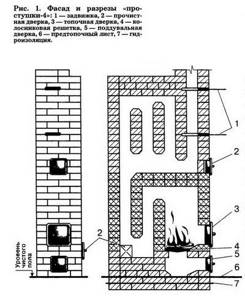
Bykov two-bell oven
The design of the Bykov furnace is somewhat different from the two-bell furnace. The lower part is the combustion chamber and consists of ascending and descending channels. The top one is made in the form of a cap, divided by five channels, made in the form of a sieve. Due to this, the area that comes into contact with hot gases becomes larger. And this in turn significantly increases the efficiency of the furnace.
Double-bell ORPs have a simple design, but they are not easy to build. To build such a furnace, you need to have at least some experience, or choose a simpler structure, such as the one named after Bykov. It is best to consult a professional first to avoid troubles with smoke in the room or other problems.
Second thermal load
Nothing works on bare principles. In order for a theoretically absolutely correct stove to heat, dry and cook well, it must also be made correctly in the material. In relation to bell-type furnaces (and especially double-bell furnaces), this means that the thermal load on the material must be high. Making a bell furnace massive, with thick walls, is like lighting a fire in a cave. To feel the warmth, you need to sit next to the fire, and there will be soot...
c309b8141378ec4433e1fa6a65105e41.jpe
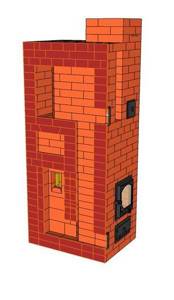
eb9a96611664c70a0b926656370364e4.jpe
Take a look at fig. On it are drawings and orders of some Kuznetsov stoves: a bathhouse. heating and cooking. a double-circuit hot water boiler and an improved Russian stove with a stove bench. Not being an experienced stove maker, it is clear that the material per unit of output power (500 W * sq. m of outer surface) in the Kuznetsov stove uses one and a half to two times less than in traditional ones. In general, any bell-type oven is “emptier” inside than a channel oven of equal power.
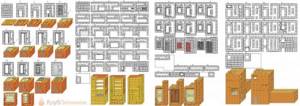
Orders of some Kuznetsov furnaces
On the one hand, this is good; bricks and mortar cost money. But on the other hand, it requires careful development and adherence to construction technology (see below). The heat load, which would not cause a pile of cobblestones to move, would destroy a thin brick wall even during the accelerating fire.
Structural mechanics are also important for Kuznetsov furnaces. The strength of the wall with clay mortar decreases much faster when its thickness decreases than with cement-sand mortar. Therefore, the foundation for these furnaces must be done especially carefully in strict accordance with the author’s recommendations. They must be strictly followed during construction.
Note: I.V. Kuznetsov allows freely copying his materials for himself, for construction, but objects to republications. However, the pictures in Fig. small. An amateur cannot build anything using them, but a master knows where to get full-fledged drawings. Therefore, we hope that Igor Viktorovich will forgive us this small borrowing for the benefit of the cause.
How to make Kuznetsov brick stoves with your own hands
IN AND. Kuznetsov developed a large number of furnace designs. Some types of stoves can be made with your own hands. To do this, you will need the order of the furnaces and their drawings.
Many, knowing about the positive reviews about Kuznetsov’s stoves, and also in order to save money, begin to build them themselves. Everything will work out, of course, but for this you need to use the appropriate materials and strictly follow the procedures.
Materials used for the construction of the Kuznetsov furnace:
- Fireclay brick;
- Clay brick brand M150;
- Good quality clay;
- Cleaned sand;
- Metal fittings.
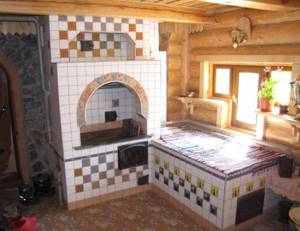
For the construction of internal masonry, fireclay bricks are used. According to the order, you can calculate its quantity. For the construction of external masonry, clay bricks are used, preferably grade M 150. Its quantity is also calculated using the same order. It is recommended to use only good quality clay for mortar. Purified sand for masonry is used twice as much as clay. You can use commercially available clay-sand mixtures. For 500 bricks you will need about 0.2 cubic meters. m of clay-sand mixture. In addition, you will need grate bars, two doors (blower and furnace), two steel corners and five meters of wire. Kuznetsov’s book “Building stoves and fireplaces: a practical guide” will help you build the structure you need. It presents all types and designs of stoves and fireplaces.
How to build a structure?
The ordering of the Kuznetsov or Podgorodnikov two-bell furnace is carried out in accordance with the operating diagram. Before taking any measures to arrange the facility, you need to study all the main points that the drawings contain. Half of the mistakes that a brick structure will have in the future are related precisely to the incorrect implementation of the project. After the foundation is ready, the process of laying out the furnace begins. Brick rows are laid in strict order, each subsequent row is measured at the building level for errors in work. The final stage of the work is the construction of the chimney structure. After all the oven elements are ready, you should start the device for the first time. The test run should not be carried out at full power, so it is not recommended to use large amounts of fuel.
Kuznetsov furnaces design and principles of operation, advantages, variations, drawings
Kuznetsov's stoves are well known not only to stove makers - they heat many homes in Russia and abroad. I.V. Kuznetsov has been working on improving furnaces since 1962 and has gathered around him a strong team of like-minded people. The team has more than one and a half hundred developments to its credit, covering almost the entire range of household stoves, see fig.
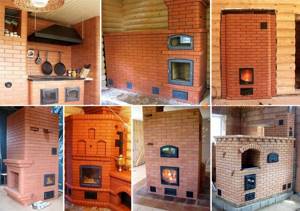
Some of the furnaces of I.V. Kuznetsov
Many would like to build one of Kuznetsov’s stoves with their own hands, and this article will help them. But we are not going to reveal some hidden secrets of the “blacksmiths” - they simply do not exist. On Igor Viktorovich’s website stove.ru, those interested will find a huge array of stove information for free: from information on the design and construction of stoves to detailed drawings and recommendations for installing a stove in a house and constructing a blind area around a building with stove heating. We also do not intend to criticize or correct anything in this home-stove encyclopedia: we are, to put it mildly, far from I.V. Kuznetsov in the oven business.
The purpose of this article is to provide a kind of introduction to Kuznetsov’s body of information, allowing one to more freely navigate the source material. Let us explain with an example why this is necessary.
Let's say I'm a generalist auto mechanic with extensive experience and want to pass it on to others who are interested. A car is a complicated thing. If I begin to get distracted along the way, explaining in detail that how running and caster (let’s assume that readers are not exactly dummies, now everyone drives) affect the handling and directional stability of the car, and the valve timing diagram affects fuel consumption depending on road conditions. conditions, and so on, I will eventually become confused to the point that I myself will no longer understand how the car I drive works. Willy-nilly, I will have to present the material, albeit “on the fingers,” but in a professional, fluent manner.
However, it will be a little difficult to read even for specialists like me, but for an amateur it will make his head spin. Therefore, I will need someone to help me, who can be called a “half-teapot”. In fact, he is not a kettle at all; he can adjust the suspension and set the valve lifters himself. But in this case, his task is to describe how the entire filling of the car is assembled into one whole, controlled according to the principle: “steer with the steering wheel, gas with the gas, brake with the brake.”
In the automotive industry of the USSR, a similar situation arose in the late 50s and early 60s, when the industry began producing cars for wide sale to the public. Then the super bestseller of that time, “How a Car Works,” was published. Edited by none other than the most important designer of the legendary “Victory”, A. A. Lipgart.
Information “from the recipient” will not yet allow you to start working: it does not provide deep knowledge that will allow you to at least intuitively estimate the required values of numerical parameters along the way. But it is essentially fundamental: mastering it, a professional text can be read with understanding and faster. And, if somewhere in it something is still unclear, it no longer causes loss and wandering, but simply a mark in the mind: this is what you need to find out in more detail.
The government has not yet adopted any landmark resolutions on stoves and stove heating. But their role in household heat and power engineering in times of energy shortage is undeniable: already a heating stove with an efficiency of 70%, when used on a large scale, will provide fuel savings on a national scale, because The designs of new heating plants include heat losses in the mains of 35%, and it is not yet possible to reduce them. So, with the popularization of stove knowledge, you have to figure it out yourself, without being either Lipgart or Kuznetsov. Well, let's try.
More about round ones
Round stoves theoretically have a lot of advantages, but they are not very convenient in the house. However, there is also a significant demand for compact mobile ovens, and here the extremely high efficiency of round multi-caps can be a decisive factor, because when the size of the oven decreases, its efficiency drops sharply due to the square-cube law.
Such furnaces, of course, would have to be made of metal. This solves the problem of cleaning; the stove can be made collapsible. But the choice of metals suitable for the ratio of heat capacity and thermal conductivity is extremely limited. The only inexpensive ones are cast iron, but it is heavy and fragile.
However, there is a lighter and stronger metal material with similar properties. These are products of powder metallurgy. In relation to scissor knives, “powdered crap” is quite justified, but for a stove in which nothing works for shear, powdered parts can be a godsend.
The second problem, which has already been mentioned, is the heat-resistant lining on the arch of the first cap. If it can be solved, then perhaps the works and efforts of Igor Viktorovich Kuznetsov will bear fruit that is more extensive and significant than it now seems.
Operating principle of ovens with two hoods
The secret to the efficiency of this stove lies in its original design, which allows it to accumulate and save heat for a long time. To understand the operating principle of a two-bell furnace, let’s consider its design diagram.
After kindling in winter, hot flue gases rise under the arch of the lower hood, transferring heat to the surrounding walls and hob. But new air enters the combustion chamber, the combustion process continues and the release of hot combustion products continues, displacing cooled gases under the top of the bell. Those, in turn, descend and fall into a vertical channel leading to the upper bell, where the two-bell design of the furnace provides for the repetition of the previous process with the release of gases out through the chimney.
The temperature of the exhaust flue gases is lower than any other stove with a stove, since they intensively transfer their heat to the walls of the stove. For this reason, chimneys of heat sources of this design must be protected from the destructive effects of condensation. After heating is completed, the heat remains for a long time at the top of both hoods, even if the main valve remains open. Cold air entering through the ashpit cannot rise under the hood arch and passes into the chimney along the path indicated in the diagram by blue arrows.
A two-bell cooking stove with a stove allows you to cook food in the summer thanks to an additional valve, the opening of which allows gases to pass directly into the chimney pipe. If the valve is not opened completely, then the flow of combustion products will be divided into two, going along different paths. In this way, in the autumn-spring period, you can regulate the intensity of heating of the hoods, that is, the thermal power of the stove.
Operation scheme and device
The basis of two-bell furnaces are the following elements:
- ash chamber;
- firebox;
- vertical caps;
- cleaning doors;
- valves;
- cooking chamber, drying chamber and/or oven.
At the very bottom there is an ash chamber, and above it a firebox. A hob is installed above the fuel chamber. A drying room is installed in the second hood.

Operating principle of two-bell furnaces:
- Hot gases from the firebox enter through the entrance to the lower bell.
- Heated gases are lighter than air, so they rise to the very top of the bell, giving off some of the heat to its walls.
- Cooling down, they begin to descend along the side walls of the cap to its base.
- Since new portions of hot gas are constantly entering inside, the cooled gas is forced out into a vertical channel leading to the second bell.
- Once inside, they rise to the upper ceiling and give off some of their heat. As they cool, the gases descend along the walls to the base of the bell and exit through the pipe.
Note!
Double-bell furnaces operate on the principle of free movement of gases, without forced draft. One of the advantages of two-bell stoves is that even if you do not close the valve on the pipe after the stove is heated, the incoming cold air from the firebox will not cool it. There is heated air in the top of the hood, because of this the cold air cannot rise. It is immediately discharged through a side vertical channel from the lower bell into the second. In it, cold air also does not rise, but passes along its base and is removed out through the pipe.
If you install a valve in the ceiling of the first hood under the chimney pipe, you can regulate the heating of the stove. In the open position, coming from the firebox, hot air rises to the top of the lower hood, and from it is drawn out into the pipe. The oven itself will not heat up, only the hob. This heating mode is especially convenient in the summer.
If the valve is not completely closed, then some of the gases will immediately be released outside, and the rest, giving off heat to the walls of the lower bell, will pass through the vertical channel into the upper one. Having also transferred part of the heat to the walls of the second hood, the gas will escape through the chimney pipe to the outside. This ability to regulate is convenient in the spring and autumn periods.
Double-bell heating and cooking stoves are well heated from below, each horizontal row has the same temperature on all sides, increasing on the next higher rows.
With oven
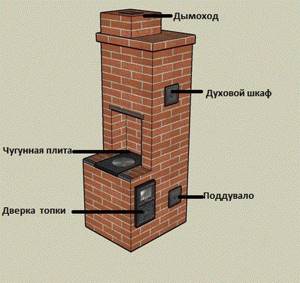
The design of double-bell ovens allows you to build in not only a hob, but also an oven. A metal oven will help you cook food, and at the same time will be an additional source of heating. Most often it is located next to the firebox. As a result, the heated gas coming from the fuel chamber heats the oven on the sides and top. The cooled gas is discharged through a vertical channel.
The advantage of a two-bell fireproofing oven with an oven is that as soon as the oven has been lit, you can open the cabinet door slightly, and the room will heat up faster. Because the oven heats up first.
Features of the Kuznetsov furnace
Since the main goal of Kuznetsov’s developments was efficiency and productivity (he worked to increase the efficiency value), this required a fundamentally new and improved approach.
From the above, the conclusion follows: the system of free movement of gases created by this master is more natural, it optimizes the operation of the device and uniform heating. In addition, soot formation is minimized.
In addition to these advantages, Kuznetsov furnaces have other positive aspects:
- combustion occurs without soot and smoke;
- heating is more uniform;
- better heat transfer;
- the need for cleaning is ten times less;
- efficiency;
- there is more space to place the steel heating element;
- low level of heat loss;
- resistance to cracks;
- the ability to change the shape and design of the structure.
Construction of the Kuznetsov furnace
In most models that were invented earlier, hot gases always moved through channels. During their movement, the structure heated up and then cooled down. This movement of gases was created by draft. At the same time, the body was heated unevenly, which ultimately led to cracks. The heat exchanger was placed in the firebox because there was no more room for it. There it came into direct contact with fire and its service life quickly expired.
d929e2742175cf2fa25982de10eadaee.jpe
Kuznetsov used a completely different principle of gas movement for his model. The stove has hoods turned upside down. The caps can be mounted on top of each other and tied together with a dry seam, as a result of which gas begins to pass through them from one cap to another. It is because of this principle of operation that the Kuznetsov furnace is also called a bell furnace.
Improve your designs I.V. Kuznetsov started in 1962, and a large number of like-minded people gathered around him. Many summer residents also want to create a Kuznetsov stove with their own hands. Let’s say right away that you can build a Kuznetsov bell furnace with your own hands, but like-minded masters did not reveal many of the hidden secrets, or maybe they simply don’t exist.
It is worth noting that, thanks to the operating principle of the Kuznetsov stove, it is possible not only to create separate heating in the house, but also to obtain a supply of hot water. To do this, the rear side of the hood must be equipped with a steel heat exchanger.
Advantages of the Kuznetsov bell furnace:
- Smoke gases are stratified throughout the entire structure equally after the combustion chamber.
- One building may have not one, but several hoods. They will help achieve more warmth.
- The hood is located near the firebox and all carbon monoxides enter it. Therefore, ash, carbon monoxide and volatile hydrocarbons, which in other furnaces exit through the chimney, in this case burn out under the hood. This will increase heat transfer and minimize soot production.
- With the help of their convection, all products formed as a result of combustion cannot escape from the oven, so they give up their heat to it.
- The heat exchanger in this building is located in the hood or outside the combustion chamber, so it does not affect the temperature of the fire and cannot reduce efficiency.
Types of bell furnaces
I.V. Kuznetsov has developed more than one and a half hundred models of furnaces that can be used for a variety of purposes.
Moreover, their configuration and dimensions may vary depending on the location of the caps. Typically, in order to save space occupied by the furnace, the hoods are positioned vertically. On top of each other. But they can be positioned horizontally. In this case, the stove turns out to be low, but long.
Having first encountered Kuznetsov’s stoves on his website, amateur stove makers are confused about the labeling of stoves, not knowing which design to choose for specific purposes.
Kuznetsov’s marking system for his furnaces is not difficult:
- IOK – pure heating stove;
- HOVIC - heating and cooking without the use of fireclay bricks;
- OVIK BK – heating and cooking room with a side fireplace;
- OVIK ZK – heating and cooking room with rear fireplace;
- OVIK L – heating and cooking with a stove bench;
- The letter “D” is added to the marking index if there is an oven;
- PKIK 1 K – ovens with a built-in heater;
- BIC – sauna stoves;
- RTIC - Russian bell-type stoves.
Based on the markings, you can select the required type of oven. The advantage of any Kuznetsov stove project is that for each type there are several sizes with different heat transfer performance. And each project is given in relation to the layout and area of the heated room. Therefore, there is no need to make independent rather complex calculations in order to choose one option or another.


